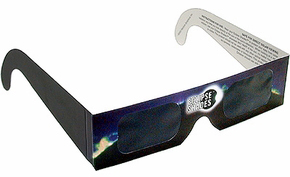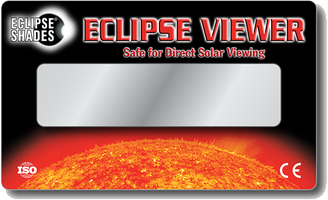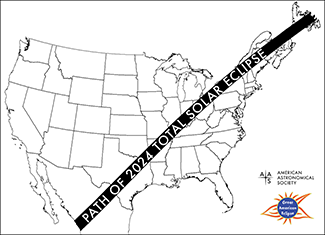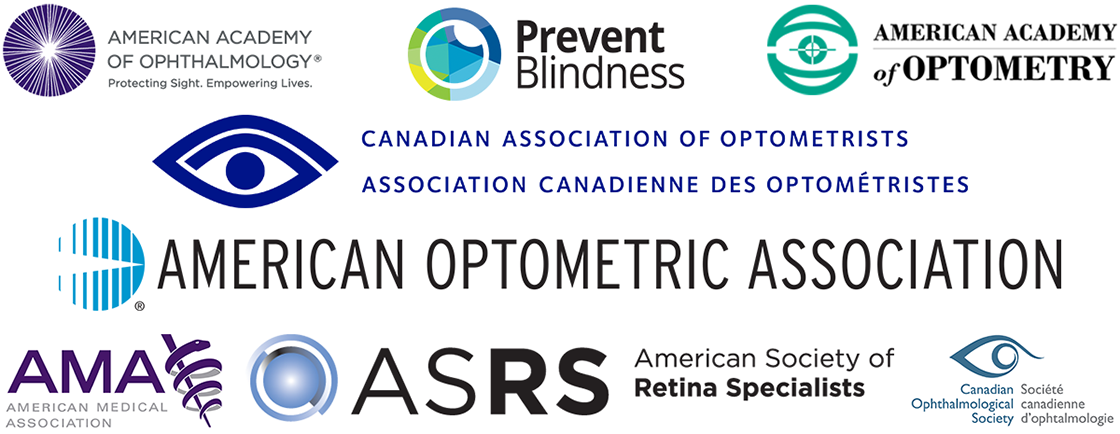How to Use Solar Viewers | Indirect Viewing Methods | Do Solar Viewers Expire? | Cleaning Instructions | Welding Filters
A solar eclipse occurs when the Moon blocks any part of the Sun's bright face. On Monday, April 8, 2024, a solar eclipse will be visible (weather permitting) across nearly all of North America. All 50 U.S. states (excluding most of Alaska) will experience at least a partial solar eclipse, as will most of Canada, all of Mexico, and all countries in Central America. Anyone within a roughly 115-mile-wide path across Mexico, from Texas through Maine, across parts of Eastern Canada will experience a total solar eclipse, one of the most spectacular sights in all of nature.
During a partial or total solar eclipse, such as the one on April 8th, looking directly at the Sun is unsafe except during the brief total phase ("totality"), when the Moon entirely blocks the Sun’s bright face, which happens only within the narrow path of totality. At all other times, it is safe to look directly at the Sun only through special-purpose solar filters that comply with the transmittance requirements of the ISO 12312-2 international standard. To find out whether your home or any other location lies within the roughly 115-mile-wide path of the April 8, 2024, total solar eclipse, see Xavier Jubier's Google Map.


 The only safe way to look directly at the uneclipsed or partially eclipsed Sun is through special-purpose solar filters, such as “eclipse glasses” (example shown at left) or handheld solar viewers (example shown at right). Ordinary sunglasses, even very dark ones, are not safe for looking at the Sun; they transmit far more sunlight than is safe for our eyes. See our Suppliers of Safe Solar Viewers & Filters page for sources of solar viewers verified to be compliant with the transmittance requirements of the ISO 12312-2 international safety standard.
The only safe way to look directly at the uneclipsed or partially eclipsed Sun is through special-purpose solar filters, such as “eclipse glasses” (example shown at left) or handheld solar viewers (example shown at right). Ordinary sunglasses, even very dark ones, are not safe for looking at the Sun; they transmit far more sunlight than is safe for our eyes. See our Suppliers of Safe Solar Viewers & Filters page for sources of solar viewers verified to be compliant with the transmittance requirements of the ISO 12312-2 international safety standard.
Instructions for the Safe Use of Solar Filters/Viewers
Instructions for All Solar Eclipses
- Always inspect your solar filter before use; if scratched, punctured, torn, or otherwise damaged, discard it. Read and follow any instructions printed on or packaged with the filter.
- Always supervise children using solar filters.
- If you normally wear eyeglasses, keep them on. Put your eclipse glasses on over them, or hold your handheld viewer in front of them.
- Stand still and cover your eyes with your eclipse glasses or solar viewer before looking up at the bright Sun. After looking at the Sun, turn away and remove your filter — do not remove it while looking at the Sun.
- Do not look at the uneclipsed or partially eclipsed Sun through an unfiltered camera, telescope, binoculars, or other optical device.
- Similarly, do not look at the Sun through an unfiltered camera, telescope, binoculars, or any other optical device while using your eclipse glasses or handheld solar viewer in front of your eyes — the concentrated solar rays could damage the filter and enter your eyes, causing serious injury.
- Seek expert advice from an astronomer before using a solar filter with a camera, telescope, binoculars, or any other optical device; note that solar filters must be attached to the front of any telescope, binoculars, camera lens, or other optics.
Additional Instructions for the Total Solar Eclipse
- If you are inside the path of totality on April 8, 2024, remove your solar filter only when the Moon completely covers the Sun’s bright face and it suddenly gets quite dark. Experience totality, then, as soon as the bright Sun begins to reappear, replace your solar viewer to look at the remaining partial phases. Note that this applies only to viewing without optical aid (other than ordinary eyeglasses). Different rules apply when viewing or imaging the Sun through camera lenses, binoculars, or telescopes; consult an expert astronomer before using a solar filter with any type of magnifying optics.
- Outside the path of totality, and throughout a partial solar eclipse, there is no time when it is safe to look directly at the Sun without using a special-purpose solar filter that complies with the transmittance requirements of the ISO 12312-2 international standard.
Not everyone in a family or other group of observers needs their own eclipse glasses or handheld solar viewer. A partial solar eclipse, and the partial phases of a total solar eclipse eclipse, progress quite slowly; there’s no point in watching continuously. If you instead take a brief glance every few minutes, the motion of the Moon across the Sun’s face will be readily apparent. There’s plenty of time to share a small number of solar viewers among a large group.
What If You Don't Have a Safe Solar Filter/Viewer?
 An alternative method for safe viewing of the partially eclipsed Sun is indirectly via pinhole projection. For example, cross the outstretched, slightly open fingers of one hand over the outstretched, slightly open fingers of the other, creating a waffle pattern. With your back to the Sun, look at your hands’ shadow on the ground. The little spaces between your fingers will project a grid of small images on the ground, showing the Sun as a crescent during the partial phases of any solar eclipse. Or just look at the shadow of a leafy tree during a partial eclipse; you'll see the ground dappled with crescent-shaped Suns projected by the tiny spaces between the leaves. A colander makes a terrific pinhole projector, as does a straw hat, a perforated spoon, or anything else with lots of small holes in it. Do not look at the Sun through the pinhole(s)!
An alternative method for safe viewing of the partially eclipsed Sun is indirectly via pinhole projection. For example, cross the outstretched, slightly open fingers of one hand over the outstretched, slightly open fingers of the other, creating a waffle pattern. With your back to the Sun, look at your hands’ shadow on the ground. The little spaces between your fingers will project a grid of small images on the ground, showing the Sun as a crescent during the partial phases of any solar eclipse. Or just look at the shadow of a leafy tree during a partial eclipse; you'll see the ground dappled with crescent-shaped Suns projected by the tiny spaces between the leaves. A colander makes a terrific pinhole projector, as does a straw hat, a perforated spoon, or anything else with lots of small holes in it. Do not look at the Sun through the pinhole(s)!
Do Eclipse Glasses & Handheld Viewers Expire?
If your eclipse glasses or viewers are compliant with the transmittance requirements of the ISO 12312-2 safety standard, and if their filters aren't scratched, punctured, torn, coming loose from the frame, or otherwise damaged, you may reuse them indefinitely. Furthermore, you may look at the uneclipsed or partially eclipsed Sun through them for as long as you wish. Some glasses/viewers are printed with warnings stating that you shouldn't look through them for more than 3 minutes at a time and that you should discard them if they are more than 3 years old. Such warnings are outdated and do not apply to eclipse viewers compliant with the ISO 12312-2 standard and in excellent condition. To make sure you get (or got) your eclipse glasses/viewers from a supplier of ISO-compliant products, see our Suppliers of Safe Solar Viewers & Filters page. And to maintain your solar viewers in excellent condition, store them at room temperature, either in the case or package they came in or in an envelope or other container that will keep them clean and dry and protect them against scratches and punctures.
Is It Safe to Clean Eclipse Glasses and Handheld Solar Viewers?
Manufacturers of hard plastic eclipse glasses often supply a microfiber pouch that you may use to wipe the lenses clean. The same pouch may be used on the lenses of cardboard eclipse glasses and handheld solar viewers. You may also wipe them clean with any soft, nonabrasive tissue or cloth; Kimwipes are also suitable, but baby wipes and other wet wipes are not suitable. Cardboard must be kept dry; if it gets wet, it will swell and likely detach from the lenses. Do not use water, glass cleaner, or any other solvents or liquids to clean cardboard eclipse glasses and handheld solar viewers.
Are Welding Filters Safe for Solar Viewing?
The ISO 12312-2 standard was based, in part, on decades of experience using welding filters for observing the Sun. A welding filter with a shade number of 12 or higher transmits a safely tiny percentage of the Sun's light across the spectrum, whether made of tempered glass or metal-coated polycarbonate. Most observers find the view through a shade 12 welding filter uncomfortably bright and the view through a shade 15 or higher-numbered welding filter unattractively dark. The "sweet spot" is shade 13 or 14, which best matches the view in purpose-made eclipse glasses and handheld solar viewers, except that the image is green rather than yellow-orange or white. Shade 13 and 14 welding filters are rarely stocked in welders' supply stores, though, so you'll probably have better luck finding them by shopping online. Two good sources of shade 14 welding filters are safesolarviewing.com and Phillips Safety Products.
You should not use adjustable and/or auto-darkening welding helmets or similar products to view the Sun. Many don't go as dark as shade 13 or 14, and even those that do post a grave risk to your eyesight, either because you accidentally adjust them to an unsafe setting or because they don't auto-darken fast enough when you look at the Sun with them.
A solar eclipse is one of nature’s grandest spectacles. By following these simple rules, you can safely enjoy the view and be rewarded with memories to last a lifetime.
This safety information is provided by the American Astronomical Society (AAS), the National Science Foundation (NSF), the National Oceanic and Atmospheric Administration (NOAA), and the National Aeronautics and Space Administration (NASA). It has been endorsed by the American Academy of Ophthalmology, the American Academy of Optometry, the American Medical Association, the American Optometric Association, the American Society of Retinal Specialists, the Canadian Association of Optometrists, the Canadian Ophthalmological Society, and Prevent Blindness.

Note: This web page does not constitute medical advice. Readers with medical questions should contact a qualified eye-care professional.
More eclipse safety tips from the AAS:
- 1-Page Eclipse Safety Flyers (English, Spanish)
- Detailed Technical Report on Solar Eclipse Eye Safety
- Suppliers of Safe Solar Viewers & Filters
- About the ISO 12312-2 Standard for Solar Viewers
- Eyewear & Handheld Viewers
- Projection: Pinhole & Optical
- Solar Filters for Optics: Telescopes, Binoculars & Cameras
Safety tips from our partners and endorsers:
- Eye Safety During a Solar Eclipse (NASA)
- How to Look at the Sun Safely (Sky & Telescope)
- Solar Eclipses and Eye Safety (American Optometric Association)
- Solar Eclipse Eye Safety (American Academy of Opthalmology)
- Solar Eclipse Eye Safety: Protect Your Eyes from the Sun! (Prevent Blindness)

